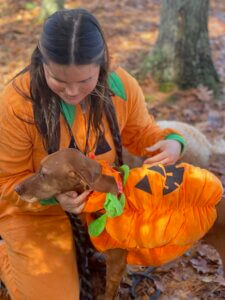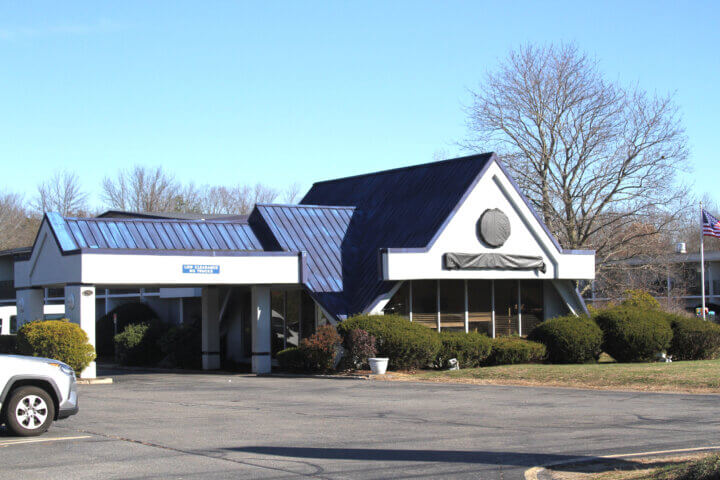When Jodi Dakin Loughlin’s Vizsla, Tenney, plunged through the ice of a pond near her home, her dog walker rushed to the rescue.
Tenney is “very lucky to be safe and sound after a heroic rescue at the end of our street,” a grateful Loughlin said.
Shauna Butler of Walden Pet Services and Tenney were out for a stroll last Friday morning near Balls Hill Road when the 6-year-old dog “ran out onto the ice, likely chasing a bird or animal. The ice was thin in the middle, and she fell through. She went under two times,” according to Loughlin.
After calling for help, “Shauna physically broke all of the ice all the way out to where Tenney was, very far out,” she said.
“Shauna was able to walk out and was up to her neck on her toes when she finally grabbed the dog. Getting out to Tenney took some time, as she broke all the ice along the way. They were able to walk in.”
Meanwhile, as the Concord Fire Department rushed 10 rescuers to the scene of the mishap, the other dog, Lefty, “sat on the shore like a good boy, waiting,” Loughlin reported.
As it happened, said Assistant Fire Chief Brian Whitney, members of the department “had just started to do our annual ice rescue training” at the time of the approximately 10:40 a.m. call and had their lifesaving equipment and protective gear at the ready.

Finding Butler and Tenney had managed to struggle ashore, first responders began treating the duo for hypothermia, according to Fire Chief Thomas Judge.
They loaded Butler onto a Stokes basket — a rescue stretcher or litter — and carried her a quarter-mile to a clearing, and from there, in a CFD rough terrain vehicle, to a parking lot.
Butler was subsequently taken to the hospital by ambulance. Loughlin said Tenney, after her release from Woburn Animal Hospital, took some time to relax and recuperate in Warren, Vermont with her family (and a copy of The Concord Bridge).

Butler, who’s from Marlborough and has been walking Tenney and Lefty five days a week for two years, said the crisis unfolded in the course of seconds.
“There wasn’t much time to think. I felt as though my two options were to wait here and she may drown, or to go in and get her, and the first option was never an option for me,” she told the Bridge.
After pausing to call her boss at Walden Pet to let her know what was happening and tell her to call 911, Butler ventured onto the ice. Right away, she said, she knew it wouldn’t hold up enough to get her to Tenney, who was 50 feet out, “so I slid my body into a pocket of water, and had to lift myself up on the ice, breaking it as I went.”
Halfway there, Butler saw a man on the shore and yelled for help. He offered to join her in the water, but she urged him to wait until she and Tenney emerged.
Once they were out, the man, later identified by Walden Pet as Joe Rigali, “literally gave me the jacket off his back to warm me up after, and tried to keep Tenney and I calm as he went to get help for us. I don’t feel as though words can explain how grateful I am that he was there,” she said.
“To have gotten out of that water and had to have been alone would’ve been terrifying.”
Butler also offered her heartfelt thanks to the first responders who “made sure to try and keep us as calm, safe, dry and warm as possible as they got us out of there” and to a coworker, Eliza, “who also gave the shirt off her back” to keep Butler and Tenney warm, as well as her boss, who stayed with her after the ordeal and at the hospital.
Of Tenney’s parents, Butler said the Loughlins have “always treated me like family, not just their dog walker. Doing what I needed to do to save Tenney was the only option for me. I’ve always told my clients, ‘I will do whatever it takes to keep your pets safe while they’re under my care,’ and I truly meant it.”
Loughlin was brimming with praise for Butler after what could have been a disaster. “Walden Pet is an incredibly well run pet services company whose walkers form deep bonds with their clients. They love my dogs and I am so grateful that they care for them like their own,” she said.
In addition to her gratitude to CFD first responders, she said she’s thanked Butler “a million times, and she keeps telling me that she would do it again the next time without even thinking twice.”

While Friday’s story ended without tragedy, not all falls through the ice have a happy ending.
“Our firefighters worked swiftly and professionally to help this woman and dog get to safety after falling through the ice, and we are happy that they are alright,” Judge said.
“We would like to remind members of the community that our recommendation is to stay off the ice, but if you choose to do so, to proceed with great caution and be prepared.”
The Commonwealth’s Department of Fire Services reports that “each year, New England residents safely enjoy boating, fishing, ice skating, and ice fishing, but many are injured from exposure to cold water. Skaters and ice fishermen fall through the ice and boaters capsize. Hikers sometimes have to camp overnight in harsh weather conditions.”
And, of course, DFS says, “unleashed pets run onto ice and people chase them.”
CFD’s Whitney said the department had responded to 16 water or ice rescue situations in the five years prior to Friday’s emergency. He said CFD generally encourages people to stay off the ice for their safety, and that the town does not test or mark frozen bodies of water as “safe” for skating or other activities.
“There’s no guarantees, so the safest bet is to stay off the ice,” Whitney said.
DFS also warns that “ice on moving water in rivers, streams and brooks is never safe,” while “the thickness of ice on ponds and lakes depends upon water currents or springs, depth and natural objects.”
Even ice over stiller waters may not be considered fully “safe,” because temperature changes cause it to expand and contract, weakening it.
If someone does go through the ice, DFS says it’s best to call 911 — and not follow them into the water. If possible, instead extend a branch, pole or ladder to the person who fell through.
A person who falls into cold water and emerges should get into a Heat Escape Lessening Position (that’s HELP), bringing the knees to the chest, holding the arms close to the sides, clasping the hands, and covering the head if possible. A group that falls through together should huddle to preserve warmth.
“Surface ice thickness depends on much more than just temperature: currents, depth, topography, and other factors mean that surface ice can vary even over short distances,” Jake Wark of DFS told the Bridge.
“The only truly safe ice is at a skating rink.”






